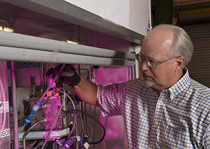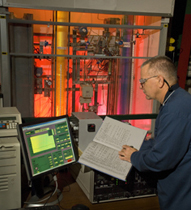Powering the Cars of the Future
Clean hydrogen fuel cells are moving closer to reality with help from emissions-free nuclear power
 When you pull up to a filling station in the future, just what will you be “filling up” with? Will you recharge your batteries from an electrical outlet, pump in fuel made from scrap wood or grass, or perhaps feed your fuel cell with hydrogen? Researchers at the U.S. Department of Energy are working on all of these options to power our cars in cleaner, practical, and cost competitive ways. For those that envision a future full of hydrogen fuel cell-powered cars, the trick is how to pull hydrogen out of water using as little energy and producing as few emissions as possible in the process. This is one of the challenges being addressed at the Department of Energy’s Savannah River National Laboratory (SRNL). When you pull up to a filling station in the future, just what will you be “filling up” with? Will you recharge your batteries from an electrical outlet, pump in fuel made from scrap wood or grass, or perhaps feed your fuel cell with hydrogen? Researchers at the U.S. Department of Energy are working on all of these options to power our cars in cleaner, practical, and cost competitive ways. For those that envision a future full of hydrogen fuel cell-powered cars, the trick is how to pull hydrogen out of water using as little energy and producing as few emissions as possible in the process. This is one of the challenges being addressed at the Department of Energy’s Savannah River National Laboratory (SRNL).
“You’ve probably heard of the very appealing attributes of hydrogen as the fuel of the future, including the fact that it is the most abundant element on the planet,” says Dr. Bill Summers, manager for SRNL’s Hydrogen Production Program. “The catch is, almost all of that hydrogen is locked up in water or other compounds, and it takes energy to get it out. Nuclear reactors are an excellent means to provide this energy because they avoid using fossil fuels and emit no greenhouse gases during operation.”
 Summers and team are working to advance the Hybrid Sulfur Process, one of the leading candidates for using high-temperature heat from advanced nuclear reactors to generate hydrogen from water. “What is appealing about the Hybrid Sulfur Process,” Dr. Summers says, “is that it is brilliantly simple, yet highly efficient. Simplicity makes it reliable and cost effective; high efficiency minimizes the number of reactors and other resources needed to meet the huge energy needs of our transportation system. The process is also environmentally friendly: You put in water, electricity and heat; there’s some sulfur dioxide that recycles and stays within the process; and all that comes out is hydrogen and oxygen.” The two-step process uses two types of chemical reactions. One is driven by electricity; the other is driven by heat. Both could be powered by a nuclear reactor. Summers and team are working to advance the Hybrid Sulfur Process, one of the leading candidates for using high-temperature heat from advanced nuclear reactors to generate hydrogen from water. “What is appealing about the Hybrid Sulfur Process,” Dr. Summers says, “is that it is brilliantly simple, yet highly efficient. Simplicity makes it reliable and cost effective; high efficiency minimizes the number of reactors and other resources needed to meet the huge energy needs of our transportation system. The process is also environmentally friendly: You put in water, electricity and heat; there’s some sulfur dioxide that recycles and stays within the process; and all that comes out is hydrogen and oxygen.” The two-step process uses two types of chemical reactions. One is driven by electricity; the other is driven by heat. Both could be powered by a nuclear reactor.
The first step uses a unique electrolyzer (a device that uses electric current to split water into hydrogen and oxygen), built and tested by SRNL. This sulfur dioxide depolarized electrolyzer, or SDE, uses significantly less electricity than conventional electrolyzers. It produces hydrogen at one pole of the device. High-temperature heat drives the thermochemical reaction to regenerate the sulfur dioxide and releases the oxygen. About one-fourth of the energy used would be electrical energy, and three-fourths would be high-temperature thermal energy.
So far, SRNL has demonstrated the technology with a single-cell version of the electrolyzer, including a successful 100-hour test showing that it can operate continuously. The laboratory is now testing a multi-cell version, designed and constructed in a partnership with Giner Electrochemical Systems LLC, capable of producing 100 liters per hour of hydrogen. The information gained from this work will be used to design and construct an integrated system that combines the SDE and thermochemical portions of the process. The long-term goal is to build an engineering demonstration of the Hybrid Sulfur Process that can be operated in conjunction with planned Next Generation Nuclear Plant, scheduled for operation after 2017 at the Department of Energy’s Idaho National Laboratory. When ultimately put into use for full-scale production, an advanced reactor plant combined with the Hybrid Sulfur Process will produce enough hydrogen to power more than one million fuel cell cars.
“We’re actually building on work from the 1970s, when the nation first became interested in reducing our reliance on foreign oil,” Dr. Summers says. “That’s when Westinghouse Electric Corporation initially invented the process, known at the time as the Westinghouse Sulfur Cycle. Technology advances, as well as the huge increase in fuel costs, now make this process more attractive than ever.”
“Achieving the goal of clean, domestically-fueled hydrogen cars for the American family is going to require large, large quantities of hydrogen. I am very excited to be part of a program that could be a major contributor to making that goal a reality.”
Media Contact: Department of Energy Public Affairs (202) 586-4940
Related DOE links:
- The Savannah River National Laboratory is one of the Department of Energy’s seventeen National Laboratories. As the applied research and development laboratory at DOE's Savannah River Site, SRNL puts science to work to meet important national needs in the areas of environmental management, energy security, and national and homeland security. It is recognized as a world-class center of excellence for the development and application of unique and innovative science and technology solutions.
|
 |